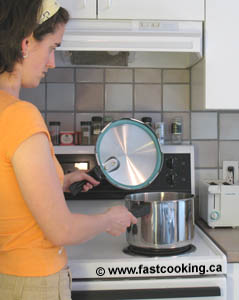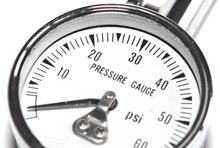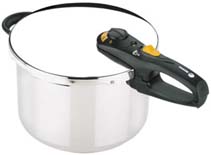The New Generation Pressure Cooker Experts
How Pressure Cookers Work |
Cooking under Pressure
Why food cooks so much faster in a pressure cooker
Pressure cookers are the fastest way to cook delicious meals. Below is a description of how a pressure cooker works. The basic pressure-cooking principle is quite simple and offers many advantages over using an ordinary pot, slow cooker or an oven. Modern new generation pressure cookers are also very easy and safe to use.
Here’s what we cover on this page:
- A brief introduction to how pressure cookers work.
- A detailed explanation of how pressure cookers work.
How Does a Pressure Cooker Work?

Pressure cookers are widely used in many parts of the world. A generation ago, they were an essential tool in Canadian and American kitchens; today, they are making a comeback.
Pressure cookers are widely used in Europe (especially food-loving France and in Spain where they are called an olla express), Asia, South America and India and have been making a resurgence in the U.S. and Canada with over one million in use in the U.S.
Pressure-cooking is a cooking method that uses steam sealed in a pressure cooker, which is a special airtight cooking pot. Sealing a liquid such as water, wine, stock or broth in a pressure cooker traps the vapour that rises from the liquid. This in turn raises the pressure inside the pressure cooker along with the maximum temperature that the liquid can reach. The increased temperature and pressure significantly speed up the cooking process. The pressure infuses the hot steam into the food. Pressure-cooking can cook foods in 1/3 the ordinary time on average and often over 10 times faster. Compared to a microwave, the food tastes considerably better and compared to slow cooker, only takes a fraction of the time.
The section below answers in more detail the question: “how does a pressure cooker work?”
Related information about pressure cookers:
![]() how do new pressure cookers compare to mom's old pressure cooker?
how do new pressure cookers compare to mom's old pressure cooker?
![]() what to look for when selecting a pressure cooker
what to look for when selecting a pressure cooker
The Higher the Pressure, the Shorter the Cooking Time
In a pot at sea level that doesn't have a cover on it, water boils at 100ºC (212ºF). The steam that evaporates from this pot is also at 100ºC (212ºF). No matter how much heat is supplied to the water, it will remain at 100ºC (212ºF). If a well sealed cover is put on the pot to trap the steam that would otherwise evaporate, the pressure inside the pot goes up. As the pressure rises, the temperature of the water and steam inside the sealed pot (the pressure cooker) also rises above the normal 100ºC (212ºF) boiling point temperature.

What’s the pressure?
Look for 15 pounds (psi).
| Pressure Inside The Pressure Cooker | Cooking Temperature |
| 0 pounds (psi) | 100ºC (212ºF) |
| 5 pounds (psi) | 104ºC (220ºF) |
| 10 pounds (psi) | 113ºC (235ºF) |
| 15 pounds (psi) | 121ºC (250ºF) |
Cooking
temperatures at different pressures:
the higher the pressure, the shorter the cooking time.

The easy-to-use spring-type pressure regulator on a modern pressure cooker. The pressure regulator controls the pressure inside the pot.
The higher the pressure of the pressure cooker, the shorter the cooking time. For example, when the pressure selector dial on a modern pressure cooker, such as a Fagor Duo new generation pressure cooker, is turned to its High setting, it is safely under a pressure of 15 pounds per square inch (psi). Many people simply refer to “psi” as pounds of pressure. To put 15 pounds of pressure in perspective, it is less than half the pressure of the air found in car tires, so is not very much; but still, the pressure inside the pressure cooker is still able to significantly shorten the cooking time of food. The temperature inside the pressure cooker is raised beyond what is possible with an ordinary pot where water normally boils at 100ºC (212ºF). At 15 psi, the temperature increases to 121ºC.
The steam pressure inside the pressure cooker cooks food much, much more rapidly than just boiling or baking food. Unlike microwave cooking, pressure-cooked foods become moist and succulent with an intense intermingling of flavours. Pressure-cooked foods retain much more of their vitamins and nutrients than boiled or commercially processed foods do.
Related information about pressure cookers:
![]() how do new pressure cookers compare to mom's old pressure cooker?
how do new pressure cookers compare to mom's old pressure cooker?
![]() history of the pressure cooker
history of the pressure cooker
Learn More About Pressure Cookers
- pressure cooker cookbooks
- how pressure cookers work
- cooking times for pressure cookers
- recipes for pressure cookers
- health benefits of pressure-cooking
- slow cookers compared to pressure cookers
- what to look for in a pressure cooker
- cost savings when pressure-cooking
- shop for a pressure cooker
More Time for You
|
New Generation Quiet, easy-to-use, European-designed Reasonably Priced
Fagor is Available at Food Fast, Without the Guilt.TM |

